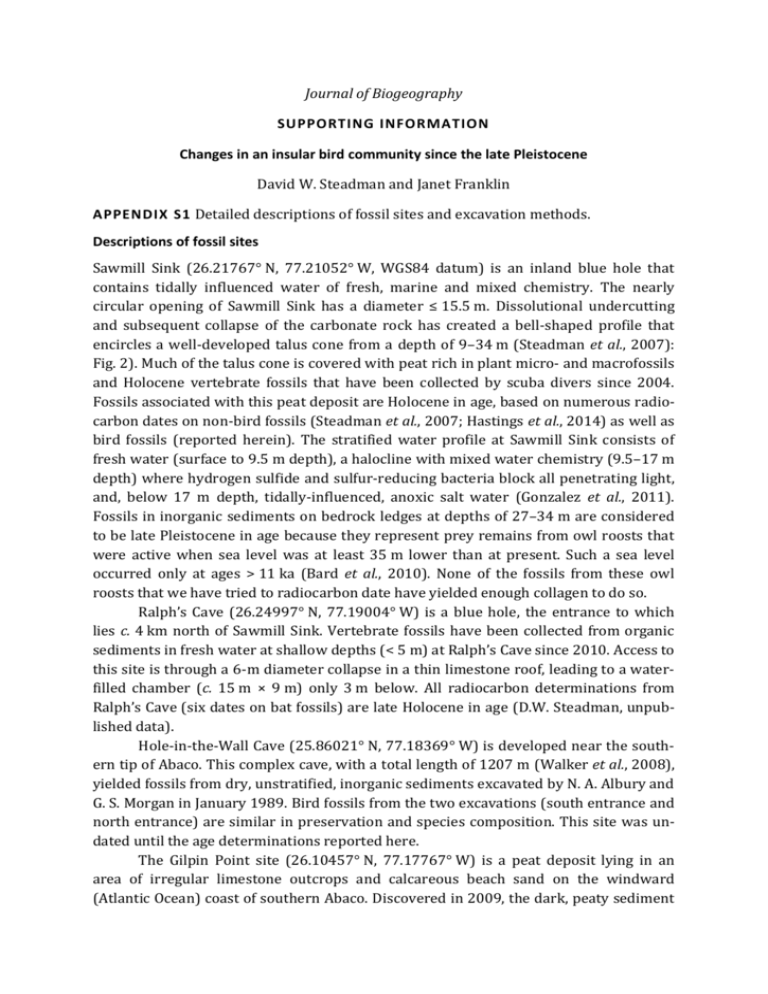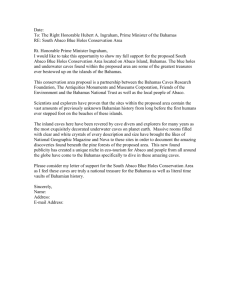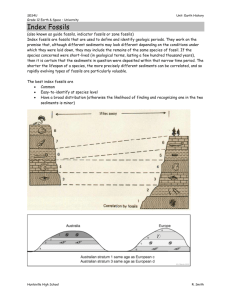jbi12418-sup-0001-AppendixS1-S3
advertisement

Journal of Biogeography SUPPORTING INFORMATION Changes in an insular bird community since the late Pleistocene David W. Steadman and Janet Franklin APPENDIX S1 Detailed descriptions of fossil sites and excavation methods. Descriptions of fossil sites Sawmill Sink (26.21767° N, 77.21052° W, WGS84 datum) is an inland blue hole that contains tidally influenced water of fresh, marine and mixed chemistry. The nearly circular opening of Sawmill Sink has a diameter ≤ 15.5 m. Dissolutional undercutting and subsequent collapse of the carbonate rock has created a bell-shaped profile that encircles a well-developed talus cone from a depth of 9–34 m (Steadman et al., 2007): Fig. 2). Much of the talus cone is covered with peat rich in plant micro- and macrofossils and Holocene vertebrate fossils that have been collected by scuba divers since 2004. Fossils associated with this peat deposit are Holocene in age, based on numerous radiocarbon dates on non-bird fossils (Steadman et al., 2007; Hastings et al., 2014) as well as bird fossils (reported herein). The stratified water profile at Sawmill Sink consists of fresh water (surface to 9.5 m depth), a halocline with mixed water chemistry (9.5–17 m depth) where hydrogen sulfide and sulfur-reducing bacteria block all penetrating light, and, below 17 m depth, tidally-influenced, anoxic salt water (Gonzalez et al., 2011). Fossils in inorganic sediments on bedrock ledges at depths of 27–34 m are considered to be late Pleistocene in age because they represent prey remains from owl roosts that were active when sea level was at least 35 m lower than at present. Such a sea level occurred only at ages > 11 ka (Bard et al., 2010). None of the fossils from these owl roosts that we have tried to radiocarbon date have yielded enough collagen to do so. Ralph’s Cave (26.24997° N, 77.19004° W) is a blue hole, the entrance to which lies c. 4 km north of Sawmill Sink. Vertebrate fossils have been collected from organic sediments in fresh water at shallow depths (< 5 m) at Ralph’s Cave since 2010. Access to this site is through a 6-m diameter collapse in a thin limestone roof, leading to a waterfilled chamber (c. 15 m × 9 m) only 3 m below. All radiocarbon determinations from Ralph’s Cave (six dates on bat fossils) are late Holocene in age (D.W. Steadman, unpublished data). Hole-in-the-Wall Cave (25.86021° N, 77.18369° W) is developed near the southern tip of Abaco. This complex cave, with a total length of 1207 m (Walker et al., 2008), yielded fossils from dry, unstratified, inorganic sediments excavated by N. A. Albury and G. S. Morgan in January 1989. Bird fossils from the two excavations (south entrance and north entrance) are similar in preservation and species composition. This site was undated until the age determinations reported here. The Gilpin Point site (26.10457° N, 77.17767° W) is a peat deposit lying in an area of irregular limestone outcrops and calcareous beach sand on the windward (Atlantic Ocean) coast of southern Abaco. Discovered in 2009, the dark, peaty sediment Journal of Biogeography Supporting Information at Gilpin Point is inundated today by the ocean under normal circumstances, as well as covered by calcareous sand in the summer months (Steadman et al., 2014). Access to the sediment is typically only possible during very low (spring) tides associated with certain new and full moons in the autumn, winter and spring. The peat can be exposed and then completely covered by sand over a single tidal cycle. Wood, snails and bones occur throughout the vertical sequence of the peaty sediment at Gilpin Point, which is late Holocene in age based on a variety of dated materials (Steadman et al., 2014). Field data collection Underwater palaeontological operations in blue holes use industry-standard cave-diving techniques and scientific diving protocols (details in Steadman et al., 2007). All fossils and associated sediments collected at Sawmill Sink and Ralph’s Cave have both vertical (water depth) and horizontal (N–S, E–W grid) coordinates. The samples were sealed in Ziploc bags and plastic boxes to secure them within their original water chemistry (anoxic salt water for Sawmill Sink, fresh water for Ralph’s Cave) during transport to the laboratory. Preparation in the lab consisted of a series of increasingly fresh water washes to remove salts, followed by gradual air-drying. Fossils from dry caves (Hole-in-the Wall Cave and Banana Hole) were excavated with minimal vertical and horizontal control within the unstratified sediment, and retrieved by both dry-screening and water-screening through nested sieves of 12.5, 6.4, 3.2 and 1.6-mm mesh (Olson & Pregill, 1982). Fossils from the intertidal peat deposit at Gilpin Point were retrieved from 1.5–6 L blocks of sediment excavated with a square shovel and water-screened either in the field (nested sieves of 12.5, 6.4 and 1.6-mm mesh) or in the lab (nested sieves of 12.5, 5.6, 3.35, 2.0 and 1.0-mm mesh; details in Steadman et al., 2014). Certain very delicate avian fossils were consolidated by applying Butvar (polyvinyl acetate); no fossils treated with Butvar were radiocarbon-dated. No chemicals were applied to any other fossils except for specimens lightly encrusted with calcium carbonate, which was etched away through soaking for 30–90 min in dilute (3–5%) acetic acid. REFERENCES Bard, E., Hamelin, B. & Delanghe-Sabatier, D. (2010) Deglacial meltwater pulse 1B and Younger Dryas sea levels revisited with boreholes at Tahiti. Science, 327, 1235–1237. Gonzalez, B.C., Iliffe, T.M., Macalady, J.L., Schaperdoth, I. & Kakuk, B. (2011) Microbial hotspots in anchialine blue holes: initial discoveries from the Bahamas. Hydrobiologia, 677, 149–156. Hastings, A.K., Krigbaum, J., Steadman, D.W. & Albury, N.A. (2014) Domination by reptiles in a terrestrial food web of The Bahamas prior to human occupation. Journal of Herpetology, 48, 380-388. Olson, S.L. & Pregill, G.K. (1982) Introduction to the paleontology of Bahaman vertebrates. Smithsonian Contributions to Paleobiology, 48, 1–7. Steadman, D.W., Albury, N.A., Maillis, P., Mead, J.I., Slapcinsky, J.D., Krysko, K.L., Singleton, H.M. & Franklin, J. (2014) Late-Holocene faunal and landscape change in the Bahamas. The Holocene, 24, 220–223. Steadman, D.W., Franz, R., Morgan, G.S., Albury, N.A., Kakuk, B., Broad, K., Franz, S.E., Tinker, K., Pateman, M.P., Lott, T.A., Jarzen, D.M. & Dilcher, D.L. (2007) Exceptionally well preserved late Quaternary plant and vertebrate fossils from a blue hole on Abaco, The Bahamas. Proceedings of the National Academy of Sciences USA, 104, 19897–19902. Walker, L.N., Mylroie, J.E., Walker, A.D. & Mylroie, J.R. (2008) The caves of Abaco Islands, Bahamas: keys to geologic timelines. Journal of Cave and Karst Studies, 70, 108–119. D. W. Steadman & J. Franklin Pleistocene–Holocene changes in an insular bird community 2 Journal of Biogeography Supporting Information APPENDIX S2 Island areas and interisland distances estimated for sea levels from the Last Glacial Maximum to early Holocene. Island areas for the Bahamian Archipelago and Greater Antilles (Table S1), and interisland distances from the Little (Table S2) and Great Bahamas Banks (Table S3) were estimated for early Holocene (c. 12–11 ka) and Last Glacial Maximum (c. 23–19 ka) sea levels. We used a global topographic database that includes seafloor topography (Smith & Sandwell, 1997) and well-accepted references for late Quaternary sea levels (Clark & Mix, 2000; Bard et al., 2010) to estimate the land areas of Bahamian islands and their interisland distances during and since the LGM (23–19 ka). Global topographic data were available at 1-minute (roughly 2 km) resolution from http://topex.ucsd.edu/cgibin/get_data.cgi (accessed 1 Jun 2012). These point data were interpolated to a raster grid by kriging, and then reclassified for each of the target sea levels. A sea level of -40 m was used to represent 12–11 ka; we also calculated land areas and interisland distances for sea levels of −35 and −45 m to account for uncertainty in sea-level curves and topographic data. A −120-m sea level is estimated for the LGM (Yokoyama et al., 2000), with uncertainty characterized using −105 and −135 m. Areas and distances were calculated by projecting each new shoreline map (WGS 1984 UTM Zone 17N), and then measuring the shortest distance between islands. Analyses were carried out using ARCMAP 9.3 (ESRI, Redlands, CA). Current land areas of islands are from the United Nations Island Directory (http://islands.unep.ch/isldir.htm; accessed 24 Jun 2012). REFERENCES Bard, E., Hamelin, B. & Delanghe-Sabatier, D. (2010) Deglacial meltwater pulse 1B and Younger Dryas sea levels revisited with boreholes at Tahiti. Science, 327, 1235–1237. Clark, P.U. & Mix, A.C. (2000) Ice sheets by volume. Nature, 406, 689–690. Smith, W.H.F. & Sandwell, D.T. (1997) Global sea floor topography from satellite altimetry and ship depth soundings. Science, 277, 1956–1962. Yokoyama, Y., Lambeck, K., De Deckker, P., Johnston, P. & Fifield, L.K. (2000) Timing of the Last Glacial Maximum from observed sea-level minima. Nature, 406, 713–716. D. W. Steadman & J. Franklin Pleistocene–Holocene changes in an insular bird community 3 Journal of Biogeography Supporting Information Table S1 Current and estimated island area (km2) at sea levels corresponding to c. 12– 11 ka (−40 m, with −35 m and −45 m representing uncertainty), and c. 23–19 ka (−120 m, with −105 m and −135 m). Areas under lower sea levels estimated from global topographic data available in 1-minute (roughly 2 km) resolution from http://topex .ucsd.edu/cgi-bin/get_data.cgi (accessed 1 June 2012). Current areas are from the United Nations Island Directory (http://islands.unep.ch/isldir.htm; accessed 24 June 2012). Sea level Island group Current Little Bahama Bank 1224 (Ab) 1096 (GB) 4887 (An) 6754 (Ot) 770 Great Bahama Bank Turks and Caicos Cuba Hispaniola Puerto Rico Jamaica 105,805 73,929 9100 11,190 −35 m −40 m −45 m −105 m −120 m −135 m 13,880 14,254 14,550 16,492 16,748 17,004 92,297 93,359 94,279 102,231 103,030 103,670 1385 (Nc) 1077 (Sc) 384 (T) 162,340 83,550 16,532 13,796 2552 (C) 2647(C) 3547 (C) 3855 (C) 4192 (C) 393 (T) 162,794 84,065 17,221 13,894 406 (T) 163,234 84,624 17,749 13,992 507 (T) 165,887 87,587 20,099 14,771 510 (T) 166,294 88,094 20,218 14,970 525 (T) 166,674 88,645 20,322 15,136 Ab, Abaco; GB, Grand Bahama; An, Andros; Ot, other islands of the Great Bahama Bank (New Providence, Eleuthera, Exumas, Cat and Long); Nc, North Caicos island at lower sea level; Sc, South Caicos island at lower sea level; C, Caicos Bank; T, Turks Bank. D. W. Steadman & J. Franklin Pleistocene–Holocene changes in an insular bird community 4 Journal of Biogeography Supporting Information Table S2 Distances (km) from Abaco to other islands in the Bahamas, Greater Antilles and Florida, USA, at current sea level, and distances from the Little Bahama Bank superisland to other expanded islands at sea levels of −40 m (corresponding to c. 12– 11 ka) and −120 m (c. 23–19 ka). Distances under lower sea levels were estimated from global topographic data available at 1-minute (roughly 2 km) resolution from http://topex.ucsd.edu/cgi-bin/get_data.cgi (accessed 1 June 2012). Modern island Cuba Hispaniola Jamaica Puerto Rico Mainland Florida Grand Bahama Eleuthera New Providence Andros, North Andros, South Cat Great Exuma Long Crooked Acklins Rum Cay San Salvador Great Inagua Little Inagua Mayaguana East / Middle Caicos North Caicos Providenciales Grand Turk Current distance to Abaco (km) 412 772 811 1329 221 25 45 81 109 179 193 265 299 443 480 330 330 638 640 558 699 680 667 739 D. W. Steadman & J. Franklin Distance to Little Bahama Bank Glacial (super-) island At −40 m sea level At −120 m sea level Cuba Hispaniola Jamaica Puerto Rico Mainland Florida Little Bahama Bank Great Bahama Bank 384 770 810 1324 87 — 34 381 764 806 1312 76 — 34 Crooked / Acklins 435 428 Rum Cay San Salvador Inagua 328 327 635 316 321 629 Mayaguana Caicos Bank 555 660 548 654 Turks Bank 700 694 Pleistocene–Holocene changes in an insular bird community 5 Journal of Biogeography Supporting Information Table S3 Distances (km) from South Andros to other islands in the Bahamas, Greater Antilles and Florida, USA, at current sea level, and distances from the Great Bahama Bank superisland to other expanded islands at sea level −40 m (corresponding to c. 12– 11 ka) and −120 m (c. 23–19 ka). Distances under lower sea levels estimated from global topographic data available in 1-minute (roughly 2 km) resolution from http://topex.ucsd.edu/cgi-bin/get_data.cgi (accessed 1 June 2012). Modern island Cuba Hispaniola Jamaica Puerto Rico Mainland Florida Abaco Grand Bahama Eleuthera New Providence Andros, North Cat Great Exuma Long Crooked Acklins Rum Cay San Salvador Great Inagua Little Inagua Mayaguana East / Middle Caicos North Caicos Providenciales Grand Turk Distance to South Andros (km) 177 609 571 1233 276 179 249 141 78 14 185 138 217 343 376 262 299 494 524 473 616 598 576 656 D. W. Steadman & J. Franklin Distance to Great Bahama Bank Glacial (super-) island At −40 m sea level At −120 m sea level Cuba Hispaniola Jamaica Puerto Rico Mainland Florida Little Bahama Bank 22 304 385 930 77 34 20 301 386 926 74 34 Great Bahamas Bank — — Crooked / Acklins 45 43 Rum Cay San Salvador Inagua 25 75 186 23 68 184 Mayaguana Caicos Bank 178 275 176 273 Turks Bank 315 313 Pleistocene–Holocene changes in an insular bird community 6 Journal of Biogeography Supporting Information APPENDIX S3 Climate scatter-plots showing annual mean precipitation versus average minimum temperature of the coldest month for the six species identified on Great Abaco Island from Pleistocene but not Holocene deposits and that no longer occur in the Bahamas, and for modern and Last Glacial Maximum (LGM) Bahamas climates estimated from the Community Climate System Model (CCSM) and the Model for Interdisciplinary Research on Climate (MIROC). 2000 3000 20 10 0 -10 -20 0 1000 2000 3000 2000 3000 10 0 -10 -20 Bird points Bahamas modern LGM CCSM LGM MIROC -30 10 0 -10 -20 1000 4000 0 1000 2000 3000 Cave swallow 2000 3000 D. W. Steadman & J. Franklin 4000 10 0 -10 -20 Bird points Bahamas modern LGM CCSM LGM MIROC -30 10 0 -10 -20 -30 1000 4000 20 Short-eared owl Minimum temperature ( ° C) Annual precipitation (mm) 20 Annual precipitation (mm) Annual precipitation (mm) 4000 20 Eastern meadowlark Minimum temperature ( ° C) Cliff swallow 20 Annual precipitation (mm) Bird points Bahamas modern LGM CCSM LGM MIROC 0 -30 4000 Bird points Bahamas modern LGM CCSM LGM MIROC 0 Minimum temperature ( ° C) 20 10 0 -10 -20 1000 Bird points Bahamas modern LGM CCSM LGM MIROC Annual precipitation (mm) -30 Minimum temperature ( ° C) 0 Minimum temperature ( ° C) Eastern bluebird Bird points Bahamas modern LGM CCSM LGM MIROC -30 Minimum temperature ( ° C) Brown-headed nuthatch 0 1000 2000 3000 4000 Annual precipitation (mm) Pleistocene–Holocene changes in an insular bird community 7








